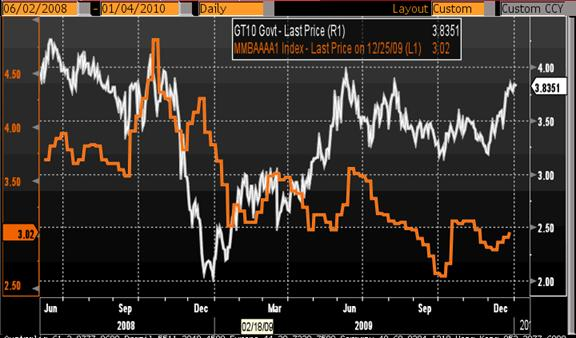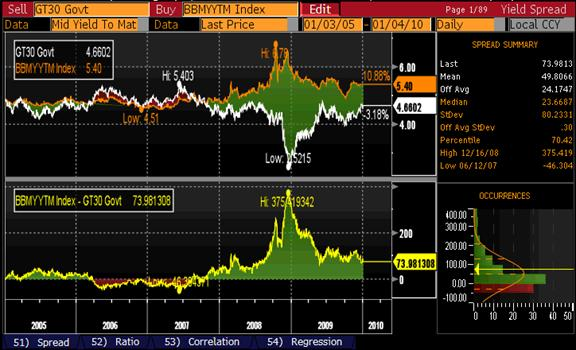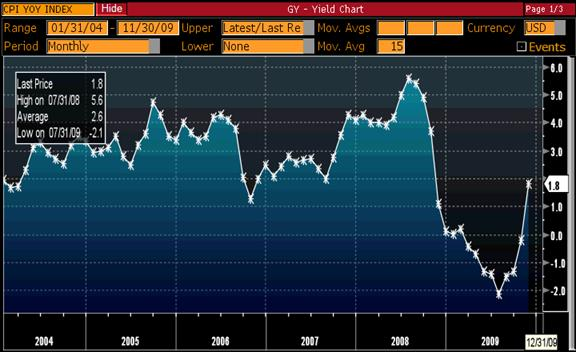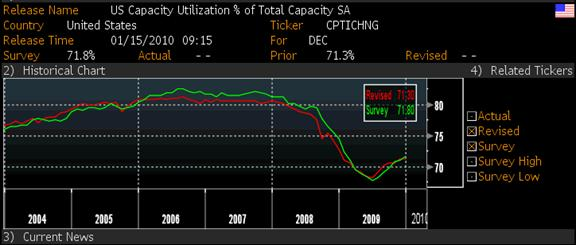John Mousseau is a portfolio manager and heads the tax-free Muni section of Cumberland. He is a member of the Management Committee of Cumberland Advisors. His bio is found at www.cumber.com. .
~~~
January 5, 2010
As we round the corner and move into 2010, we take a look at where the tax-exempt bond market will be heading and what forces will be affecting it. Some are relatively new forces and some are the usual suspects.
Build America Bonds (BABs). We mentioned this in our October piece about the year after Lehman: http://www.cumber.com/commentary.aspx?file=102009.asp .
In this chart we can see the effect that BABs had during the third quarter.
Sources: The Bond Buyer, Bloomberg, Municipal Market Advisors (MMA), and Bank of America Merrill Lynch
You can see from the chart that during the second and third quarters, BAB yield spreads fell, and this helped push tax-free yields lower – basically, removing tax-free supply for taxable BABs supply. Remember, with the 35% federal subsidy, a 6.25% BAB yield is an effective borrowing rate of 4.06% for a municipality employing them. This clearly pushed longer tax-free yields down during the middle two quarters of the year, even as Treasury yields meandered. But we can see the rise in tax-free yields in the fourth quarter. What happened? A combination of things. Mostly, the precipitous drop happened too fast. Tax-free municipal bonds are still primarily a retail-driven market, and the sudden drop in longer tax-free yields at the end of the third quarter caused something of a buyers’ strike – just as tax-free bond supply picked up somewhat. Adding to that was a rise in Treasury yields during the fourth quarter, putting some pressure on nominal yields. And third, we see that BAB spreads over Treasuries also leveled out from the declining pattern of spreads during the second and third quarters. As the momentum of the spread decline slowed, so did the race down in tax-free yields. We believe that BABs will see their authorization extended beyond 2010 by Congress. This will have the effect of keeping an overall lid on tax-free issuance, as tax-exempt issuance is transferred to BABs issuance. Thus BABs should continue to operate as a tailwind for the tax-free bond market. It is certainly a possibility that Congress may also tinker around with the BAB subsidy (currently at 35% for most issuers) as it struggles with the deficit and the attendant costs of BAB subsidies.
Credit
This chart shows where bond insurers were rated last year and where they are rated now.
| MOODY’S | S&P | |||
| 11/25/08 | 11/5/09 | 11/25/08 | 11/5/09 | |
| ACA | Not Rated | CCC | Not Rated | |
| AMBAC | Baa1 | Caa2 | A | CC |
| Assured Guaranty | Aa2 | Aa2 | AAA | AAA |
| BHAC | Aaa | Aa1 | AAA | AAA |
| CIFG | B3 | Caa2 | B | CC |
| FGIC | B1 | Not Rated | BB | Not Rated |
| FSA | Aa3 | Aa3 | AAA | AAA |
| MBIA | Baa1 | B3 | AAA | BB+ |
| National Public Finance Guarantee Corp. | Baa1 | A | ||
| Syncora (XLCA) | Caa1 | Ca | B | Regulatory Supervision |
| Radian | A3 | Ba1 | BBB+ | BBB- |
Source: BMO Capital Markets
2009 was a year where the market continued to focus on underlying credit and ignored (from a pricing standpoint) the value of insurance. Clearly this had gradations. With the merger of FSA and Assured Guaranty, the combined firm is now doing the lion’s share of what is being insured. MBIA split itself into two companies, one to continue insuring municipal bonds and the other that has the “toxic” mortgage-backed assets that got the insurance company into trouble in the first place. AMBAC is trying to do the same but has not raised the capital needed to do it. Both MBIA and AMBAC paper have been trading to underlying ratings of bonds, and insurance is ignored by the market. CIFG is having most of their book of business novated over to Assured Guaranty. Radian still enjoys a BBB- rating from Standard and Poors. Most Radian bonds have been trading 100-200 basis points behind the general market, but recently liquidity has picked up in Radian paper as the market has stretched for incremental yield. XLCA (now Syncora Guarantee) and FGIC-backed bonds are totally dependent on underlying ratings. There is no question that, at least with regards to any MBIA, AMBAC, or Radian bonds that have underlying ratings, the insurance is garnered for free in terms of yield. Thus an MBIA- (now National Public Finance) backed bond that has an “A” underlying rating and is trading as an A-rated bond is essentially delivery insurance for free. We have also seen the strange phenomenon this year of bonds with insurance trading cheaper than the identical bonds with no insurance. That is strictly the marketing handicap of having a downgraded insurer in the description on a bond. From Cumberland’s standpoint, if we are comfortable with the credit and the insurance is free (in terms of no foregone yield), then it is superior addition. We believe it will be a while before MBIA (and maybe AMBAC) are any kind of force in the market. But there are three things working in their favor: (1) It would appear most of the bad news for mortgage-backed assets is behind us. Some recovery there should help the companies. (2) By reducing staff and controlling expenses, the insurance companies are still making money, as formerly paid premiums (which are earning money in investment portfolios) are amortizing as income. (3) As bonds that they have insured mature, are called away, or become prerefunded, the charge to capital originally taken by the insurers upon the initial insurance is taken off, thus replenishing capital. It is a tough haul, but never say never.
Prerefundings
Source: Bloomberg
The above chart shows AAA tax-free yields and 10-year US Treasury yields. Since longer-term Muni bonds are issued with ten-year call features, this is the key ratio for issuers considering the prerefunding of bonds. This is the process by which issuers sell new bonds, use the proceeds to buy US Treasury securities, and then escrow or “prerefund” older, higher-coupon bonds to their first call date. This saves the issuer the difference in coupon rates between the older, higher-coupon debt and the lower, new-coupon debt, from the call date on the older bonds to maturity. This results in significant present-value cost savings for issuers. The ratio between 10-year Treasuries and tax-free rates is crucial to successful refundings. We have not seen much in the way of prerefundings in the past year, as the ratio of tax-free bonds to Treasuries have been out of whack, with tax-free bonds yielding more, not less, than Treasury securities. That is still true on the longer end, but as you can see, the ratios have cured in the ten-year range. When Muni yields hit a low at the end of September, there were a number of prerefunding deals in the works before yields spiked higher. But the much lower ratio of tax-free bonds to US Treasuries is compelling for refunding activity. We expect to see many prerefundings this year – especially of higher-coupon bonds issued in the last quarter of 2008 and first quarter of 2009. This means looking at higher-coupon “cushion bonds” as a structure of choice for the longer part of portfolios.
Tax Rates
We expect talk of the Federal marginal tax rate being hiked from 35-37% to something over 40% to assume a place in Congressional discussions, as Congress tackles the large Federal budget deficit. We expect states also to start using state income tax hikes to close their own deficits. This means that the combined federal and state tax rates will increase from their already high levels – if not in 2010 then certainly in 2011. This will definitely add to the demand for state and local tax-exempt bonds.
Inflation
Source: Bloomberg
Source: Bloomberg
The chart above shows trailing year-over-year CPI for the past five years, as well as capacity utilization. Clearly CPI is coming off the deflation prints of earlier this year, which took into account the downdraft in the economy in the wake of the Lehman Brothers bankruptcy of September 2008. However, between the high unemployment/underemployment rate (currently near 18%) and the capacity utilization figure of 71% (vs. the long-term average of over 80%), we expect inflation to remain benign. Certainly the Federal Reserve will act to raise short-term rates as some point, but for now they are concerned about the economy continuing to recover. We expect inflation to stay in the 1-2% range, which renders current intermediate and longer tax-free yields very attractive.
Summary
As we head into 2010, we realize that tax-free yields have moved lower from last year’s exaggerated highs. But the combined forces of contained inflation, higher federal and state tax rates, tax-free issuance constraints enforced by BAB issuance, and refunding activity by issuers should still make tax-free bonds a compelling investment. The key is to manage the structure of portfolios to take advantage of refunding possibilities, as well as the ability to employ lower-duration assets and cash in times of high tax-free supply. If one looks back into history at a time of high tax rates and low inflation (the 1950s), intermediate and longer-term tax-free yields were in the mid-3% range. That’s a long way from the 4.25% to 5.0% range of tax-free yields today.
John Mousseau, CFA, Vice President and Portfolio Manager, email: john.mousseau@cumber.com







What's been said:
Discussions found on the web: